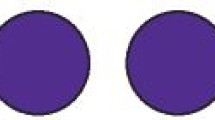Abstract
Data sources
The Cochrane Central Register of Controlled Trials, Cochrane Database of Systematic Reviews, Embase, Medline and the ClinicalTrials.gov databases.
Study selection
Randomised controlled trials (RCTs) and controlled clinical trials (CCTs) of children aged 7–12 years with class III malocclusion undergoing fixed or removable orthodontic treatment for early correction were included.
Data extraction and synthesis
Two reviewers independently selected studies, abstracted data and assessed risk of bias. The Cochrane risk of bias tool was used for RCTs and the Downs and Black and the Newcastle-Ottawa scales for CCTs. The primary outcome was correction of reverse overjet. Mean differences (MD) with 95% confidence intervals were calculated and a random effects meta-analysis conducted.
Results
Fifteen studies (nine RCTs, six CCTs) were included. Only three of the RCTs were considered to be at low risk of bias, all six CCTs were at high risk of bias.Three RCTs (141 patients) compared protraction facemask and untreated control. The results for reverse overjet (MD = 2.5 mm; 95% CI, 1.21–3.79) and ANB angle (MD = 3.90˚; 95% CI, 3.54–4.25) were statistically significant favouring the facemask group. All CCTs demonstrated a statistically significant benefit in favour of the use of each appliance. However, the studies had high risk of bias.
Conclusions
There is a moderate amount of evidence to show that early treatment with a facemask results in positive improvement for both skeletal and dental effects in the short term. However, there was lack of evidence on long-term benefits. There is some evidence with regard to the chincup, tandem traction bow appliance and removable mandibular retractor, but the studies had a high risk of bias. Further high-quality, long-term studies are required to evaluate the early treatment effects for Class III malocclusion patients.
Similar content being viewed by others
Log in or create a free account to read this content
Gain free access to this article, as well as selected content from this journal and more on nature.com
or
References
Goose DH, Thomson DG, Winter FC . Malocclusion in school children of the west Midlands. Br Dent J 1957; 102: 174–78.
Haynes S . The prevalence of malocclusion in English children aged 11-12 years. Rep Congr Eur Orthod Soc 1970: 89–98.
Foster TD, Day AJ . A survey of malocclusion and the need for orthodontic treatment in a Shropshire school population. Br J Orthod 1974; 1: 73–78.
Battagel JM, Orton HS . A comparative study of the effects of customized facemask therapy or headgear to the lower arch on the developing Class III face. Eur J Orthod 1995; 17: 467–482.
Baccetti T, Tollaro I . A retrospective comparison of functional appliance treatment of Class III malocclusions in the deciduous and mixed dentitions. Eur J Orthod 1998; 20: 309–317.
Kim JH, Viana MA, Graber TM, Omerza FF, BeGole EA . The effectiveness of protraction face mask therapy: a meta-analysis. Am J Orthod Dentofacial Orthop 1999; 115: 675–685.
Watkinson S, Harrison JE, Furness S, Worthington HV . Orthodontic treatment for prominent lower front teeth (Class III malocclusion) in children. Cochrane Database Syst Rev 2013: CD003451.
Mandall N, Cousley R, DiBiase A, Dyer F, Littlewood S, Mattick R, et al. Is early Class III protraction facemask treatment effective? A multicentre, randomized, controlled trial: 3-year follow-up. J Orthod 2012; 39: 176–185.
Keles A, Tokmak EC, Erverdi N, Nanda R . Effect of varying the force direction on maxillary orthopedic protraction. Angle Orthod 2002; 72: 387–396.
Showkatbakhsh R, Toumarian L, Jamilian A, Sheibaninia A, Mirkarimi M, Taban T . The effects of face mask and tongue plate on maxillary deficiency in growing patients: a randomized clinical trial. J Orthod 2013; 40: 130–136.
Vaughn GA, Mason B, Moon HB, Turley PK . The effects of maxillary protraction therapy with or without rapid palatal expansion: a prospective, randomized clinical trial. Am J Orthod Dentofacial Orthop 2005; 128: 299–309.
Abdelnaby YL, Nassar EA . Chin cup effects using two different force magnitudes in the management of Class III malocclusions. Angle Orthod 2010; 80: 957–962.
Liu W, Zhou Y, Wang X, Liu D, Zhou S . Effect of maxillary protraction with alternating rapid palatal expansion and constriction vs expansion alone in maxillary retrusive patients: a single-center, randomized controlled trial. Am J Orthod Dentofacial Orthop 2015; 148: 641–651.
Mandall N, Cousley R, DiBiase A, Dyer F, Littlewood S, Mattick R, et al. Early class III protraction facemask treatment reduces the need for orthognathic surgery: a multi-centre, two-arm parallel randomized, controlled trial. J Orthod 2016; 43: 164–175.
Thiruvenkatachari B, Harrison JE, Worthington HV, O'Brien KD . Orthodontic treatment for prominent upper front teeth (Class II malocclusion) in children. Cochrane Database Syst Rev 2013 (11): CD003452.
Agostino P, Ugolini A, Signori A, Silvestrini-Biavati A, Harrison JE, Riley P . Orthodontic treatment for posterior crossbites. Cochrane Database Syst Rev 2014 (8): CD000979.
Author information
Authors and Affiliations
Additional information
Address for correspondence: Badri Thiruvenkatachari, School of Dentistry, JR Moore Building, University of Manchester, Manchester, UK, M13 9PL E-mail: Badri.T@manchester.ac.uk.
Woon SC, Thiruvenkatachari B. Early orthodontic treatment for Class III malocclusion: A systematic review and meta-analysis. Am J Orthod Dentofacial Orthop 2017; 151: 28–52.
Rights and permissions
About this article
Cite this article
Smyth, R., Ryan, F. Early treatment of class III malocclusion with facemask. Evid Based Dent 18, 107–108 (2017). https://doi.org/10.1038/sj.ebd.6401269
Published:
Issue date:
DOI: https://doi.org/10.1038/sj.ebd.6401269



